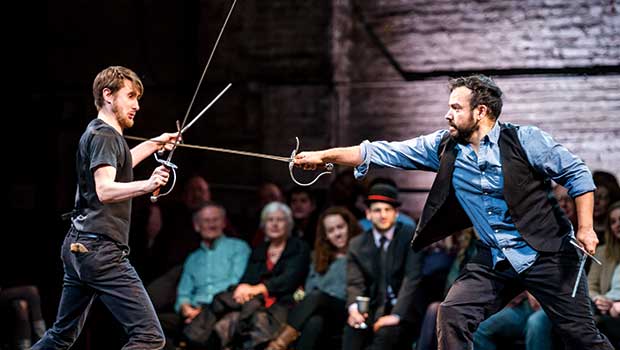
Bedlam, a New York theater company, begins its production of Shakespeare’s great tragedy “Hamlet” by plunging the theater into darkness. From this stark opening moment, this exhilarating production draws the audience in not merely as viewers of a show, but as witnesses, immersed in the action.
Taking over the Emerson Cutler Majestic Theatre in Boston, the two-hour production turns the glittering rococo theater into a performance space. The four actors zoom up and down the aisles and surround the audience as they conjure the play’s 25 characters with bravura acting but few props, and a set that consists mainly of artful lighting and the raw backdrop of the stage’s stained brick back wall.
On the web
For more information about Bedlam’s “Hamlet,” visit: artsemerson.org or http://bit.ly/2DKSjq8
The same four-person ensemble and stripped-down, riveting staging animate the other Bedlam production on stage through March 25 in this ArtsEmerson presentation — the company’s rendering of another masterpiece of English-speaking theater, George Bernard Shaw’s “Saint Joan.”
Both are directed by Eric Tucker, Bedlam’s founding artistic director, who also designed its sound (edgy musical breaks and not entirely audible vocals in scenes with fast, lengthy speeches) and costumes (everyday casual wear). Sets are by John McDermott and lighting by Les Dickert.
A portion of the audience gets to sit on stage in close proximity to the actors. Thursday night, the actors recruited a woman with orange hair and a bright floral skirt to carry a fateful flagon of poison across the stage from Claudius to Hamlet.
The lead
The only actor of the four with just one role is Aubie Merrylees. Slender and gaunt, he is not a glamorous Hamlet, and instead convincingly renders the anguish, rage and quick wit of the prince, a man who by nature is more scholar than warrior.
Prince Hamlet returns home to Denmark for the funeral of his father and finds that his mother, Gertrude, has married his father’s brother, Claudius, who is now king. A ghostly figure of his father tells him that Claudius poisoned him. Yet Hamlet seeks certainty and devises a clever ruse: he hires a band of actors to entertain Claudius and Gertrude with a play in which a king is murdered to test his uncle’s reaction. It works. Now what?
Burly Sam Massaro is terrific as a smarmy Claudius, living up to Hamlet’s description of him as a “satyr.” In a chilling scene, unaware that Hamlet is observing him, Claudius, wracked by guilt, kneels in prayer and begs forgiveness for killing his brother. Hamlet is ready to kill him but holds back — he doesn’t want to dispatch an absolved Claudius to heaven. Hamlet departs, missing what Claudius says next, “My words fly up, my thoughts remain below,” shrugging off his moment of remorse.
Wearing a brown newsboy cap, Kahlil Garcia is Horatio, Hamlet’s loyal, empathetic and even-tempered best friend. The actor takes off the cap and dons eyeglasses when, as Polonius, he spouts the pompous, longwinded speeches of the courtly old man. At one point, when Garcia is doing triple duty in another role, Hamlet holds up the cap to indicate that Horatio is by his side. Aundria Brown is an ardent Ophelia, Hamlet’s ill-starred love interest, and, flipping her long cornrows over her face as a concealing curtain at one point, she takes a comic turn as Guildenstern to Massaro’s Rosencrantz, the two students that Claudius summons to spy on Hamlet.
The Bedlam ensemble’s quicksilver changes make the audience aware of their magic-making and a conscious partner in it. They bring us into Hamlet’s world with our willing complicity.




![Banner [Virtual] Art Gallery](https://baystatebanner.com/wp-content/uploads/2024/04/NJ-H_1-713x848.jpg)

